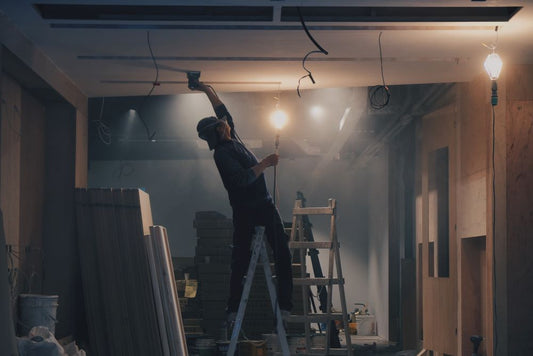It is part of the job
When you enter the masonry industry, you will be expected to handle heavy bricks as well as other heavy masonry tools and so on. Because the bricks are heavy and often need to be elevated, you have to watch how you handle them.
Improper handling of bricks is one of the leading causes of work-related injuries. By following the upcoming safety tips, you should be able to avoid most of those injuries and stay on the job for a long time.
Importance of Safety in Bricklaying
Following safety protocols are essential when working in the bricklaying industry. You will be required to climb ladders, carry heavy bricks, work with a variety of power tools, and also be exposed to hazardous materials.
It is not an easy job to do, but if you use safety guidelines, it is a job where you can avoid injury and work at it for a very long time. The importance of following safety guidelines is that it protects your health.
You need to stay fit and injury free to have a career in this construction field. Any downtime due to health issues or injuries only makes it harder for you to continue in this line of work, even if you fully recover.
Safety is important to protect your income as well.
Understanding the risks associated with bricklaying
It is easy to observe bricklayers at work. Their duties do not seem that difficult, and their pay is often very good. But before you get started in this line of work, you need to fully understand the risks that are involved in laying bricks.
One of the key items to learn is that you are not going to be standing on the ground all the time. You will need to climb ladders, walk scaffolding, and still work like you are on the ground.
Another risk you need to understand is that for the first few rows of bricks, you will be bending over. That is hard on your back as well as your arms. There are a lot of risks involved, and you should take time to learn them all and how to prepare to prevent them.
Legal Requirements and Regulations in the UK construction industry
There are three main requirements you need to follow when working in the UK’s construction industry. These are based on the principle of prevention:
#1. Avoid dangerous or hazardous situations whenever possible
#2. If the hazard, etc., is unavoidable, evaluate the risk
#3. Solve the problem at the source or implement methods that minimize the risk
The UK government puts out different safety booklets, and you can find one here and another here. It pays to find all the official legislation and booklets relating to construction safety, so you know how to handle yourself on the job.
Essential PPE for bricklayers in the UK
Any construction field has its share of risks. That is why it is important for you to wear the proper PPE or personal protective equipment. There is a booklet on this equipment called Personal protective equipment (PPE) at work regulations from 6 April 2022 that will help you find the right gear for your bricklaying duties.
Some of the common PPE are:
- Proper work gloves
- Ear plugs
- Hard hat
- Adjustable hard hat strap
- Goggles
- Safety goggles
Having the right personal protective equipment is one way to make sure your body is protected from most injuries or accidents. These are available everywhere construction supplies are sold.
Proper usage and maintenance of PPE
When your protective equipment is not in use, then you should be storing it in a clean, dry cabinet. Then if it is going to be reused, you have to clean the equipment and keep it in good condition.
Also, you are required to maintain your PPE at all times. While replacing a shoelace or cleaning the PPE is up to you, some PPE, like a safety harness, may need to be sent to the manufacturer for maintenance.
Also, you need to regularly inspect the PPE you are given. If you find any defects or your PPE is lost or ruined, you need to report these issues right away.
Ensuring a safe and organized workspace
There are five steps to achieve this goal:
- Eliminate Potential Hazards- Make sure the workplace meets all government regulations. Also, inspect the worksite for any physical or chemical hazards and dispose of them as quickly as possible.
- Provide Proper Training For Workers- Provide safety training classes for all workers, especially new employees.
- Make sure all employees have the proper safety equipment.
- Provide Safety Aids And Visual Messages About Safety- Keep first aid kits handy and conveniently located. Put safety posters up on walls, and so on.
- Create A Safety Committee- This committee should meet once a month and review safety practices and solve safety issues.
Encouraging ongoing safety training and education for bricklayers
This is important as it protects not just the worker but all workers in your employment. One untrained employee can put several other trained employees working near them.
Provide safety training classes for all employees, especially new hires. Then hold refresher courses periodically to make sure all employees are current on new regulations and practices.
One way to help encourage safety training and education are to form a safety committee that can monitor updated regulations, evaluate different risky situations, and create a plan to solve those issues.
Some additional words
Bricklaying is tough work, not only mentally but also physically. By following safety standards, you can avoid many of the risks that sideline good workers every year.
Make sure you have all the proper PPE for your brick-laying duties. Double-check those safety harnesses before you climb a ladder or scaffolding. You are responsible for seeing that all your PPE is in top shape and will protect you if the need arises.
It is always safety first in any construction job. For more safety tips and information as well as finding some great bricklaying tools, give us a call today. We can help make your workplace safer and more productive.




